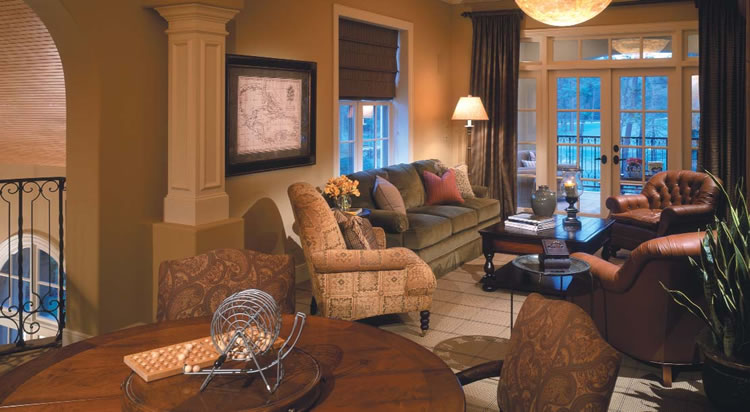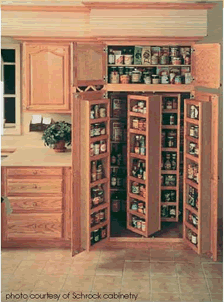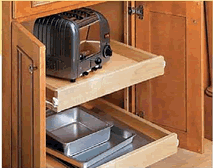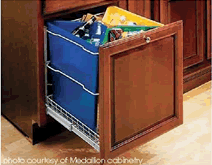Livability at a Glance™
EntertainingSpaces to Entertain Guests

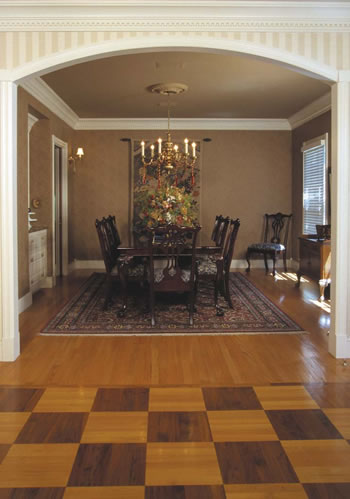
Formal Eating Area
Candlelight, soft music, ample room for guests, and great conversation make dinner parties a delight. Whether it’s a formal dinner party or a family holiday dinner, memories are intertwined with meals together. The main things to look for are space, proximity to the kitchen, and flexibility. Is the dining area a comfortable size for the table, chairs, and hutch? Is it close to the kitchen, reducing steps when carrying hot dishes or clearing the table? Should you desire privacy, can the space be closed off? If you have larger gatherings, are there two dining areas, perhaps the kids are at one table with the adults at another. Or, does your dining space flow openly into an adjacent space for additional seating?
Informal Eating Area
A table for breakfast and a snack bar for quick dinners provides several informal eating areas. The snack bar also makes a great spot to set-up a buffet.
Everyday meals mean everyday use for dinettes and snack bars. Because of its frequent use, maintenance and easy cleaning are central issues. Expect spills when you are considering flooring choices. Will you have to move chairs out of the way to sweep or vacuum? Especially at snack bars, seating suspended from the island or peninsula is a wonderful solution to ensure accessible seating that’s easy to clean under. It also helps prevent damage to the flooring from chairs!
Open Living Spaces
With the eating area, kitchen, and great room all open to each other, everyone is part of the fun. An open floor plan really pulls entertaining or family life together.
More than just eliminating walls, today’s kitchens are being designed with attention to views of fireplaces and entertainment centers. Open designs have also focused new attention on views into the kitchen. This has been one reason for the rising popularity of stainless-steel appliances and glass front cabinets.
Outdoor Living Spaces
We are naturally drawn to the outdoors. After a hectic day at work, relaxing in the outdoors helps release tension. Research shows that exposure to sunlight and trees has numerous health benefits.
Whether it’s a barbecue or outside games, outdoor entertaining should be a natural extension of your home’s flow. Covered porches are especially appreciated if inclement weather threatens your outdoor plans. For some, adding screens around the porch to control bugs means being able to truly enjoy being outside. Still others will opt for windows all around, turning their outdoor living space into a true four-seasons room.
Media-Related Entertaining
With today’s media choices running the gamut from gaming to movies or sports to the internet, until the issue of where the big screen TV goes is settled, we can’t seriously consider building or remodeling.
Lighting and sound are the major issues to be addressed. Glare from windows or other lighting can ruin the multi-media experience, so this must be under control. While one group wants to crank up the volume, others may want to carry on normal conversation or even get some shut-eye. Sound isolation clips for drywall walls and ceilings, insulating those cavities, or using acoustic sound mats are all reasonable approaches to controlling sound levels. Also, be sure to use a solid core, weather-stripped door to finish sealing off a media room.
Split Bedrooms to Control Noise
Its inevitable when friends get together that someone else in the home needs privacy – whether studying, catching up on work brought home, or needing to get some sleep. Splitting secondary bedrooms from the owner’s suite, and distancing bedrooms from entertaining areas, provides much needed quiet.
Few things in life are more important than getting a good night’s sleep. Inside the home, look for quiet products such as kitchen or bath fans and appliances. Who wants to move to another room, just because the dishwasher is running? You can also limit noise coming from outdoors through advanced insulating, caulking, and air sealing measures when your home is being built as well as quality windows and doors.
Finished Basements
A finished lower level not only adds needed square footage but allows for more informal entertaining. If you are fortunate enough to be building on a basement, today’s engineered floor systems make wide-open basement spaces feasible and affordable, as they can span greater distances than conventional lumber.
In many areas, builders are responding to tougher energy codes by insulating basements – a great start towards a comfortable living space. Make sure you know where you will want electrical and other wiring to be run and meet with your electrician to go over the plans.
Moisture and humidity are key issues in tandem with temperature. A little extra spent on basement waterproofing measures could save you from expensive repairs later. And even though your air conditioner is designed to remove excess humidity from your home in the summer, you may well find you need to run a freestanding de-humidifier in the basement as well to control humidity, mold, mildew and possible moisture damage.
Play Area
If there are children in your home, you will value a place where they can go and play. A place where toys and games are stored, and Lego creations can be left for another day. In other words, a place where kids can be kids. Separate from their bedrooms, this flexible space may or may not have been finished space when the home was initially built.
Consider the types of activities your children will enjoy. If it’s painting, you will want a flooring surface that cleans up easily and a sink nearby. Also, consider how the space may be used differently as the kids age. Keep fanciful themes to more easily changed aspects that will also keep costs down when it’s time to replace Winnie the Pooh with your child’s favorite sports theme.
The Entertaining Kitchen
Many of the best times of our lives revolve around being with family and friends. Whether it’s hosting a formal get-together, holiday dinners, or your children’s birthday parties, the kitchen is the hub of activity, A little extra attention spent planning flow, layout, and product selections will reward you with a kitchen that is more functional and efficient.
Due to the popularity of today’s open floor plans with kitchens in full view, designing kitchens is all about zones related to the flow of activity. Kitchen design is being further refined by an emerging knowledge of how layout and product choices can actually help reduce stress, particularly while entertaining.
Storage is the initial zone, because you want items to be stored in places convenient to where they will be used. For example, you’re going to want storage for your good dishes, glassware, and silverware near the serving or dining area, such as a butler pantry.
It’s also essential to reduce clutter, ease accessibility, and arrange items in an organized way. Include some roll-out drawers or trays. Drawer inserts keep small items, spices, silverware, and utensils organized. But what about small, frequently used appliances? Countertop appliance garages for blenders, toasters, and coffee makers may be just what you’re looking for. On the other hand, if you want to keep your counter space free, consider going underneath the counter. You can include a pull-out mixer shelf, which comes out of the cabinet and swings up – bringing your heavy mixer even with the countertop.
The food preparation zone depends on lots of counter space, plus proximity to the refrigerator, range/oven, and pantry. Ideally, this is a separate space from the serving area, allowing both areas to function simultaneously.
If you have a smaller island in your kitchen that will be used for food preparation, keeping the countertop a uniform height will provide the maximum work space. If your island is large enough to accommodate different levels, a 36-inch work level will be appreciated by bakers, while a taller side (usually 42 inches) shields work clutter from view and accommodates bar stools.
Your cooking zone, convenient to the food prep area, is centered around your cooktop and ovens. Two cooks in the home will require more utensils, pots, and pans, so plan storage accordingly. In addition, you may opt for separate counter spaces, cooking areas and sinks. Common ovens and waste containment may need wider corridors around a central working area.
If you are looking at an island with cooktop, make sure there is sufficient room next to the cooktop to place large items such as a big pot of boiling pasta. Also, warming drawers are great features for entertaining. They allow you to warm multiple dishes simultaneously and keep hot cooked foods at serving temperature.
Some serving zones are more formal, such as a built-in buffet in the dining area, or a butler’s pantry along the path from the kitchen. For casual entertaining, islands or peninsulas may be just the ticket. If your guests are usually adults, consider a 42-inch height for the serving bar area.
The eating zone may consist of a formal dining area, an informal breakfast nook, a snack bar, or some combination of all three. Many folks find themselves most often dining at a snack bar and rarely using their dinette. If that’s you, carefully consider what height best suits your family. If you have small children, they won’t be able to get up on higher stools (or worse yet, they may fall off!).
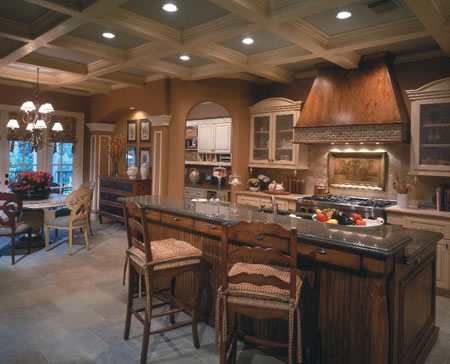
Clean-up is the final, but very important, zone when planning for entertaining. As two sinks have gained popularity, so have second dishwashers. In front of sinks, consider a small tilt-out tray to keep sponges and pot scrubbers out of view. Another item that can reduce clutter in your entertaining kitchen is a liquid soap dispenser that comes up through the countertop next to the sink.
What about trash? Typical solutions have been the unsightly tall kitchen wastebasket openly on display (or a smaller wastebasket under the kitchen sink). Besides having to bend over to use the latter, ever notice how much stuff misses the wastebasket? Opt for a pull-out wastebasket tray in your base cabinetry.
Beyond how our kitchens flow, there are several other major considerations, such as ease of cleaning and durability. Think sinks, countertops, flooring, and appliances. Laminate countertops offer the greatest variety in colors, patterns, and edge finishes. They don’t require special cleansers, nor do they need to be re-sealed every year or two.
While aesthetics and price may be the top influences for kitchen flooring choices, scratches, everyday wear, and low maintenance are major de-stressing aspects. Will spilled spaghetti sauce or grape juice stain the flooring? Darker colors of grout for tile floors are increasingly popular for this very reason. Will heavy or sharp items damage the floor if accidentally dropped? Flooring choices in adjacent areas also play a role in kitchen flooring, as many of us prefer a continuity of floor covering, which makes the entire area feel more spacious.
Appliances are one of the first items you and your guests see in the kitchen. Are the surfaces easy to clean, especially the oven/range tops and inside the microwave? How about the exterior finish? The stainless-steel look has been quite popular, but it attracts fingerprints like a giant magnet. Look for new finishes that don’t show fingerprints and are easy to clean.
Quiet is an often-overlooked aspect of a dream kitchen. Few things are more annoying than having to vacate the kitchen just to hear each other talk. Pay special attention when selecting your dishwasher and kitchen vent/hood. Some models are actually so quiet you’re not even aware they are running!
Almost universally, people describe the amount of light in their kitchens as inadequate. A light, bright, and airy kitchen is de-stressing for you, your family, and your guests. As kitchens have become more open to adjacent areas of the home, they are benefiting from increased levels of natural light coming from these areas. More recently, glass block or small traditional windows are appearing between kitchen counter backsplashes and upper cabinets.
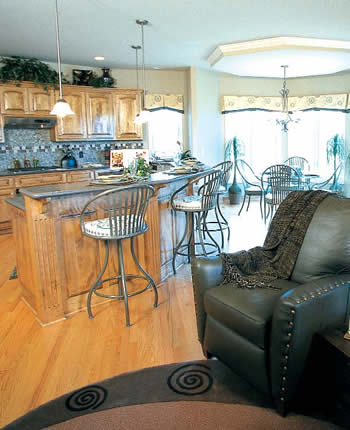
Today, recessed ceiling lighting has replaced the standard light fixture approach common years ago. As well, task lighting concealed under the upper kitchen cabinets offers a pleasant light level and helps reduce eyestrain. Whatever lighting approach you choose, make sure you’re in control. From window coverings to dimmers, lighting helps establish the mood for your next get-together. While you might want all available light when preparing dinner, controlled light levels are much more comfortable for everyone later in the evening.
Pay extra attention to where electrical outlets are located. Only you know how you intend to use the kitchen, so don’t leave it up to the electrician’s imagination where to locate outlets and switches.
Finally, consider decorating and how you reveal who you are through what you display and how you decorate your kitchen. Most use words such as “comfortable” or “homey” to describe their dream kitchen. Color choices throughout can have an exciting or a calming effect. Do you decorate according to the season? Is there space above the upper cabinets for display niches or plant shelves?
We cherish relationships. We take pride in a functional and orderly kitchen. With a little extra forethought and planning, our kitchens will beckon to entertain a simple family dinner or an extravagant gala!

